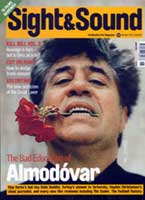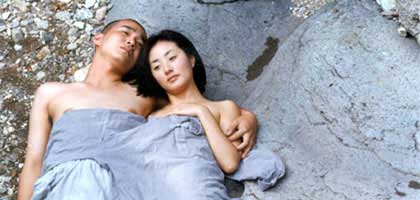
Spring, Summer, Autumn, Winter and... Spring
Republic of Korea/Germany 2003

Reviewed by David Jays
Synopsis
Our synopses give away the plot in full, including surprise twists.
An old monk educates a child in a one-room Buddhist monastery floating in the middle of a lake in Korea. In spring, the boy torments a fish, a frog and a snake by tying heavy stones to them. The old monk does the same thing to the child, warning that he will always carry such a burden in his heart. When we next see the boy, he is an adolescent. In summer, a girl comes to the monastery to convalesce. She and the young monk are gradually drawn to each other and begin a relationship. The old monk discovers them, and decides that the girl is well enough to go home. The young monk follows her.
When he returns in autumn, he is 30 and has murdered his unfaithful wife in a fit of passion. He attempts suicide, but the elderly monk helps him conquer despair by having him carve a sutra. Two policemen arrive, but are persuaded to let him complete the task before arresting him. Alone again, the old monk commits suicide. It is winter when the man, now middle-aged, returns. He begins restoring the deserted monastery. A woman brings her baby; as she leaves it behind, she falls through the ice and drowns. In spring, the man - himself now an old monk - raises the boy as he himself was raised.
Review
Kim Ki-Duk has made a name in Korea as an uncompromising director, frequently taking as his protagonists criminals and prostitutes, marginal and self-harming - as in Birdcage Inn (1998), Bad Guy (2001) and Samaritan Girl, for which he recently won the Silver Bear at the Berlin Film Festival. Beauty jars with brutality in his notorious film The Isle (2000), in which a fugitive and a prostitute meet at a fishing lake. It is marked by melancholy waterscapes and unflinchingly grim incident, in particular two gruesome attempts at suicide by ingesting fish-hooks.
Spring, Summer... might seem an anomaly in this oeuvre: it traces the education of a young monk from childhood to old age, each episode illustrated by a different season. Korean critics welcomed it as a significant departure for Kim, with its steadily lyrical visual palette and subdued sense of renewal. But beyond its poetic composition and references to Buddhist mysticism, it deals with the same alienated and marginal characters struggling to attain some kind of peace.
Even more than in The Isle, Kim distils sublime images of the natural world, aided by his conceit of the changing seasons. Spring is succeeded by a spectacular autumn of pink and orange leaves and the frozen beauty of the lake in winter. But nature here, however radiant, is also unyielding and challenging with its impacted ice and dauntingly steep hills. The childhood scenes that bookend the film reinforce a view of humanity's essentially cruel impulses that can only be curbed by constant vigilance. The boy's innocently destructive energies in the first episode see him tie stones to small struggling creatures, consumed by gap-toothed chuckles at his hampered victims. Sex too is driven by animal energies, so that the adolescent monk can't help himself copping a feel of a girl who is convalescing at the monastery.
In winter, as the season attains the same blue-grey as the monk's robes, the now middle-aged protagonist (played with coiled grace by Kim himself) takes sole responsibility for his life. This section attracts Kim's most striking cinematic gestures. The monk's rigorous martial exercises, bare-chested on the ice, are arrested in freeze-frame, seen at a distance or from above in an arresting choreography of awakening. His violent thaw is accompanied by raw vocal music, while here too is the film's one abrupt, unanticipated death, in which a mother abandoning her baby loses her footing and falls into an ice hole as she scurries away.
Each of the film's seasonal sections is announced by the monastery gates laboriously creaking open and reinforcing the suggestion of a sanctuary for damaged souls. However, the grimly truncated anecdotes of Kim's earlier work are balanced by a generously nuanced sense of time passing. Incidents gather resonance between episodes, so that the monks collect leaves in the first episode for a medicine that we see prepared in the second. In the small monastery, poised and floating on the lake, the painted wood, simple altar and bird-shaped wind chimes accrue a poignant familiarity over the decades of the narrative.
Kim's withholding, wounded characters typically stint on dialogue. They speak with sullen reluctance, and attempts at self-expression are more likely to be sawn-off lunges into violence or self-harm. Although the elderly monk in Spring, Summer... delivers several stern pronouncements, his pupil assimilates the lessons at his own anguished pace, over decades. The film's restricted vocal expressiveness encourages startling images - a woman preserving anonymity by winding a violet scarf around her face, the fabric stained with tears as she prepares to abandon her baby; the old monk's patient ritual suicide, in which he sticks small squares of cloth with the inscription "shut" over his eyes, mouth and ears, and is consumed by fire as the lake disappears into autumn mist. Although not as gut-wrenching or politically pugnacious as some of his previous work, Kim's film allows a sense of moral renewal unclouded by sentimentality and without blurring his remarkable cinematic idiom.
Credits
- Director
- Kim Ki-Duk
- Producer
- Lee Seung-Jae
- Screenplay
- Kim Ki-Duk
- Director of Photography
- Back Don-Hyun
- Editor
- Kim Ki-Duk
- Supervising Art Director
- Oh Sang-Man
- Music
- Bark Ji-Woong
